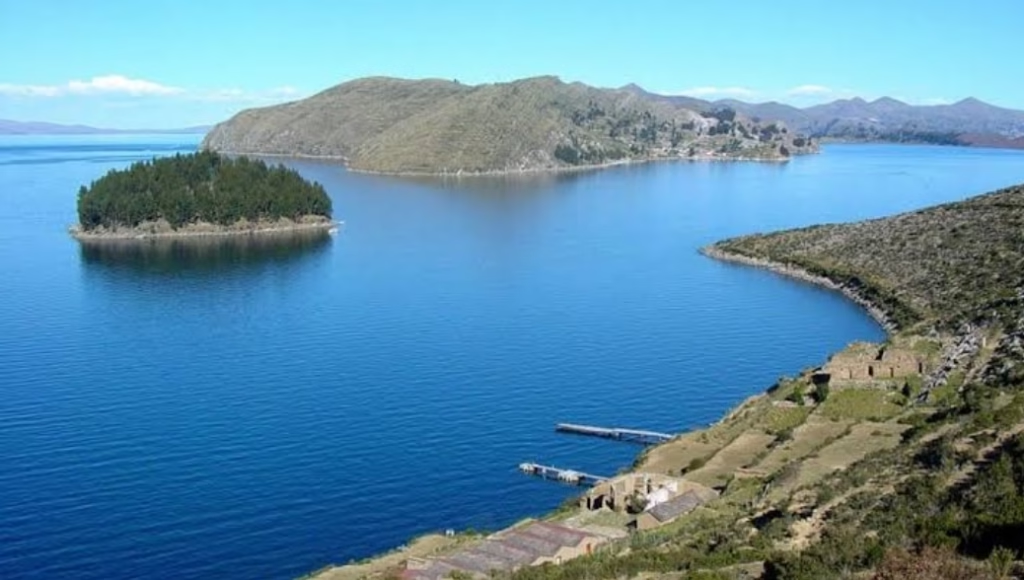
The Isla del Sol is located in the middle of Lake Titicaca. The only way to access the Isla del Sol is via Copacabana in Bolivia.
Isla del Sol Brief Summary:
The Isla del Sol is located in the middle of Lake Titicaca. The only way to access the Isla del Sol is via Copacabana in Bolivia. Copacabana is 2 hours from Puno in Peru, which is the Peruvian side of Lake Titicaca (floating islands). If you are crossing the border between Peru and Bolivia, you MUST pass through Puno and Copacabana as Lake Titicaca is shared between Peru and Bolivia. All Peru Hop and Bolivia Hop passes operate via Puno and Copacabana, making Isla del Sol very accessible.
There is a lot of Inca related history behind the stunning Isla del Sol. According to Incan legend the principal God, Inti (the Sun God), lived on one of the islands on the Bolivian side of the lake, the Isla Del Sol (Island of the Sun). Legend goes that the island is where Inti created his son and daughter, Manco Capac and Mama Ocllo, the very first Incas who later travelled north to found Cusco at the heart of what would become the Inca Empire!
Below we have created our extensive guide to the Isla del Sol based on our expert local knowledge having helped to transport over 140,000 travellers here since our formation in 2013.
Isla del Sol Guide Contents:
- How to get to Isla del Sol – Compare transportation options.
- Isla del Sol Boat Service Information – Check start time, prices, and more.
- Did you know? – Isla del Sol fun facts.
- What to bring to the Isla del Sol? – Be prepared for your tour.
- Isla del Sol FAQs– We answer your frequently asked questions.
- Photo Gallery – A few of the best photos of Isla del Sol.
Since this year there were no fun Carnival celebrations in Tarija because of the COVID pandemic, we decided to explore one of the must destinations in Bolivia: lake Titicaca. This mesmerizing lake located in the border with Peru has typically been a touristy spot for nationals and foreigners alike. Discover all there is to do in this travel guide, including tips for visiting Copacabana and the Island of the Sun (Isla del Sol).
At the end of this blog post you will find a map with all the spots mentioned in this article. Enjoy the reading and the pictures!
Lake Titicaca
Before traveling to the Titicaca lake, here are some basic facts you should know about this famous location:
- It is the largest freshwater lake in the world and it’s navigable. The lake measures 190km by 80km.
- It is also the highest lake on Earth, at an altitude of 3815 meters above sea level. This means you should take altitude sickness VERY seriously as you might experience difficulty when breathing because of the lack of oxygen. Hence, drink plenty of water or coca tea upon arrival and be careful with sports and any activity involving too much effort until your body feels more or less adjusted. If you want to be on the safe side, pack some Sorojchi pills and take one an hour before hitting your high altitude destination.
- Lake Titicaca is located in the border between Bolivia and Peru, meaning it is a shared resource by both countries. The Peruvian equivalent to Copacabana would be Puno. Since the borders were closed because of the COVID pandemic, we couldn’t cross into the Peruvian side but the usual ways to do so are in Kasani or Desaguadero.
- The lake was a sacred place for the Incas and played a a major role in Andean religious conceptions. The Incas believed their creator god Viracocha rose from its waters as well as their ancestors.
Copacabana
Copacabana is the Bolivian lakeside town closest to Isla del Sol and is actually located on a peninsula, not to be mistaken with the Brazilian beach of the same name in Rio de Janeiro.
To get from La Paz to Copacabana, you will first need to cross from San Pablo de Tiquina into San Pedro de Tiquina on a rudimentary ferry transporting both people, cars or even buses.
If you’re coming from La Paz, your first sight of the stunning lake Titicaca will be at Huarina or Huatajata, which are popular with ‘Paceños‘ for eating fresh trout and their views of the shoreline.
I bet you’ll be impressed by the deep blue color of the waters and by the vast extension of it all. It almost seemed like a real sea!
Note that there are actually two lakes: the smaller (lago Menor) and the bigger one (lago Mayor). When driving towards Copacabana, pay attention to the ‘sukakullos‘ (or ‘sukakollos‘), an ancient system of raised fields used by the inhabitants of nearby Tiwanaku to overcome the problems of drought, floods, frost and soil exhaustion. When traveling through the region, you will notice these carefully structured platforms all over. They typically stand over one meter high, with planting surfaces up to 200 meters long and 15 meters wide. Running in parallel lines, there are water-filled ditches between them.